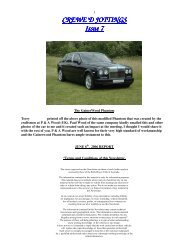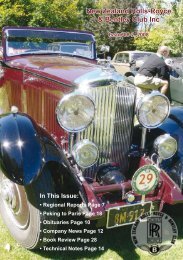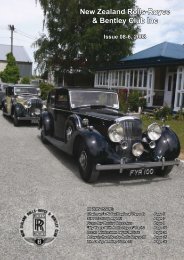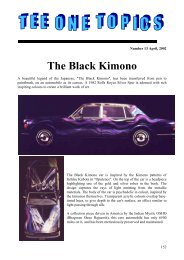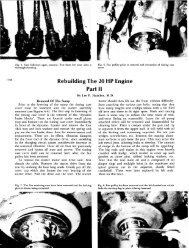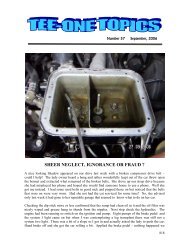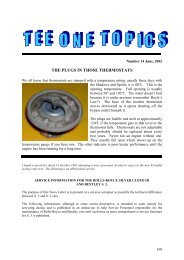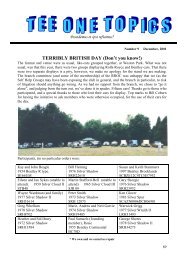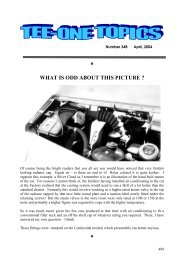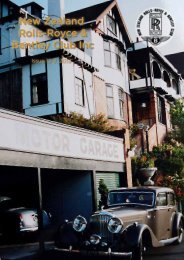April 2012 Newsletter - KDA132
April 2012 Newsletter - KDA132
April 2012 Newsletter - KDA132
Create successful ePaper yourself
Turn your PDF publications into a flip-book with our unique Google optimized e-Paper software.
to curious animals.<br />
3.propylene glycol does not persist in the environment. It is<br />
readily consumed by micro-organisms. In an activated sludge<br />
treatment plant operating at 65 deg F, PG is fully degraded<br />
within 24 hours.<br />
4. propylene glycol does not break down into corrosive elements,<br />
and can be used for many years retaining excellent aluminium<br />
protection, and prevention of lime scaling around the copper<br />
tubes in the blocks.<br />
5. Tests have shown that aluminium corrosion was lower for PG<br />
based anti-freeze than for an EG version.<br />
6. In laboratory and engine dynamometer studies, PG antifreeze<br />
has performed better than similar products containing EG with<br />
regard to cast iron cavitation corrosion.<br />
7. Fuel economy, heat transfer, and other key performance<br />
characteristics were the same for both PG and EG coolants.<br />
Public pressure in France has forced the introduction of PG.<br />
Since 1998 propylene glycol based alternatives have been<br />
available highlighting the “green” aspect. However, the latest<br />
purchases from Carrefour and Auchan (both monopropylene<br />
glycol) are now 100% “Organique” and comply with AFNOR<br />
(NRF IS<br />
601 type 3). I am not prepared to test in my cars to see if they are<br />
OK.<br />
In California, a very environmentally aware state, they have<br />
done a lot of testing on propylene glycol. Sta-Clean AntifreezeT<br />
M is one recommended product, used extensively by transport<br />
fleets, and by RROC members. It is conventionally inhibited<br />
and with correct maintenance their test fleet has run 800,000<br />
miles without changing anti-freeze. They have tested (and show<br />
a film of the test) an engine running with 8% anti-freeze added<br />
to the oil and are the only manufacturer to claim it will not harm<br />
bearings.<br />
In the UK John and Melanie Els in November 2007 introduced<br />
a website www.antifreezekills.co.uk after losing their best friend<br />
and dearest companion Barrie, a beautiful ginger cat to antifreeze<br />
poisoning. This resulted in a petition to the Prime Minister<br />
to get manufacturs to add a bittering agent: Denatonium. This<br />
failed to get Government support. They did not petition to<br />
introduce PG only stating that “Another solution is to stop using<br />
ethylene glycol and replace it with propylene glycol, although<br />
finding this alternative in stores seems to be a problem.”<br />
In 1994 (and in 2009), I also could find no product using<br />
propylene glycol marketed only for automotive use. Fernox<br />
manufactured in 1994 an automotive targeted product based as<br />
the others on ethylene glycol, but also had and still manufacture<br />
a propylene glycol product, Fernox Alphi II, which is suitable for<br />
all wet systems combining steel, cast iron, brass and aluminium.<br />
The corrosion prevention properties substantially surpass the BS<br />
6580 which makes it suitable for automotive use.<br />
For fifteen years in my Rolls-Royce cars and my 1956 Rover<br />
75, I have been using Fernox Alphi II. It is available from<br />
top quality plumbers merchants (£19.99 inc Vat and delivery)<br />
from Supreme Plumbing for five litres as compared with<br />
£19.99 inc VAT for 5 litres of Ethylene Glycol Antifreeze from<br />
MotorWorld). The ten year cost for ethylene glycol is £100 per<br />
5 litres. Fernox say it is good for 20 years in a domestic central<br />
heating system. As long as the ph level is above 7 I am on 20<br />
year changing cycles at a cost of £10 per 5 litres over 10 years.<br />
So it cheaper, and with all its advantages!<br />
I used to used a 50% mixture with ethylene glycol, and I<br />
currently do the same with propylene glycol. As we have<br />
evaporation with the old cars, I always top up with the same mix.<br />
You should note that the protection with propylene glycol does<br />
not take effect until there is a minimum 25% mixture.<br />
A word about water; untreated water is corrosive. Distilled<br />
water is the most corrosive. On no account should water from<br />
water softeners be used in an engine coolant as it contains<br />
harmful salts. Distilled water is expensive to make needing an<br />
evaporation process (cheap if you have a de-humidifier), so<br />
de-ionised water is what is sold instead (and is used in 50/50<br />
manufacturer’s mix). It is used to top up car batteries. Mains tap<br />
does contain some bad things but also some good things that<br />
help stop corrosion. If the good things are missing then extra<br />
cost is involved to add inhibitors to distilled, de-ionised water, to<br />
replace the good elements taken out from tap water.<br />
You run the risk that the inhibitor in your antifreeze may not<br />
have these added inhibitors added. However, mains tap water<br />
may have excessive solids, hardness, chlorides or sulphates, or<br />
the local water company may have added chemicals for taste and<br />
clarity reasons that are not recommended for cooling systems<br />
(fluorides, magnesium, chlorides, calcium, acids, and gases).<br />
Whether the inhibitors deal effectively with all environments in a<br />
given anti-freeze is always unclear. Given all these variables and<br />
lack of detail given on the products being sold, unless you are<br />
using Fernox Alphi II buy a 50/50 mix where you can be certain<br />
to have the best protection particularly against lime scale. Fernox<br />
Alphi II handles the hard water south of the Bristol/Wash line,<br />
the soft<br />
water of the North with the high lead content in Scotland, and<br />
similar ranges across Europe and elsewhere.<br />
I asked Fernox, Cookson Electronics, Forsyth Road, Sheerwater,<br />
Woking, Surrey GU21 5RZ to give me their comments, which<br />
follow:<br />
“It is the properties of the inhibitor which produce the durable<br />
characteristics you refer to in respect of Fernox Alphi II. As<br />
suppliers to the domestic heating market, we are obliged to<br />
use propylene glycol for the reasons of low toxicity you refer<br />
to in your article. In the past,ethylene glycol was significantly<br />
cheaper than propylene glycol and so found favour for<br />
automotive applications. However, the price differential is now<br />
much reduced and the safety benefits of propylene glycol should<br />
undoubtedly bring it into consideration for more widespread use.<br />
“Alphi 11 is used by a number of car enthusiasts as an antifreeze<br />
of choice and it is proven by the fact that it has been used for<br />
many years without any detrimental effects. It is compatibility<br />
with metal and rubbers that is important and not the specific<br />
ingredient within the inhibitor/antifreeze blend. While it is<br />
important to emphasise that the product was not specifically<br />
designed for automotive use, it does substantially surpass the<br />
requirements of BS6580 the standard for automotive anti-freeze.<br />
“Whilst propylene glycol is less dangerous than ethylene glycol,<br />
contact with skin and paint should still be avoided, as should<br />
ingestion. We recommend users to refer to the manufacturers<br />
product and safety data sheets for more specific information<br />
concerning product safety and disposal.”<br />
More images from the Southern Region Run to Lake Ohau: (Left) David Merryweather and his Silver Cloud 2 SRA67 at Mt Cook<br />
(Right) Andrew and Bruce McIlroy with John Davies and the Tibetan National Flag which GXK10 proudly fles<br />
NZRR&BC Issue 12-4 21



